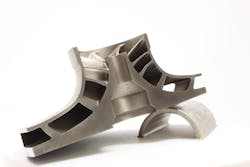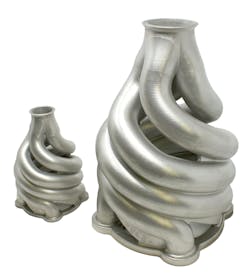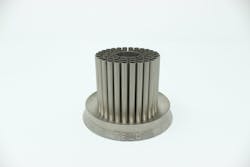The value of additive manufacturing for today’s MRO
Editor's note: Interviewee TK Kallenbach, global executive advisor to Aerospace and Defense, former CEO of the Aerosystems Branch of Zodiac Aerospace, now SAFRAN Group, is a consultant to Velo3D, which was the only AM equipment maker to attend MRO-Europe in 2019.
Q: TK, you attended the October MRO Europe 2019 event held in the UK. Can you give us your impressions on how attendees at the show were preparing for, or implementing, additive manufacturing (AM) in their product areas?
We found a mix of skeptics, some surprised folks that hadn’t yet realized how direct-to-metal AM applies to their situations, and those people that had started AM implementation on both legacy and new, optimized designs. The show was all over the spectrum in terms of what people were doing and what they thought. Overall, though, we encountered a fair amount of skepticism from the early adoption experiences versus the promises of today’s direct-to-metal AM.
I will say that those who are familiar with AM were struck by the capabilities of Velo3D and their data collection and real-time metrology to certify the quality of the print process. The information quality and real-time data gathering directly address the primary hurdle of AM adoption for certified parts, and we got very positive interest from even the toughest skeptics. The subsequent announcement of Assure software availability is paramount for AM to have wide-scale adoption for aviation parts and true serial production manufacturing. The other positive feedback for Velo3D was around the lack of support structures often required for printing parts. Many of the MRO prior experiences were “additive manufacturing to do subtractive” manufacturing. The economic advantage of Velo3D’s process was quickly recognized across the board as a breakthrough in total part-cost reduction.
Both MRO Engineers and Supply Chain leaders expressed a desire to get AM into their manufacturing cycles. This is especially true for low-volume, “impossible to obtain” parts that are becoming more common as the commercial aircraft fleet’s age.
Q: What, in your view, makes additive more ready for adoption now verses what you saw a year ago at the show?
I'd say that in comparing this year to last year, there was general improvement in AM print size, speed and materials, which attract potential adopters. The largest change was advanced by Velo3D. Industry progress on behalf of customers fundamentally must be measured by a reduction in Design for Additive Manufacturing (DfAM) work, both in upfront design time of supports, compromises to design functionality, and post-processing.
There have been two things that Velo3D brings to the table to encourage AM adoption. One is the expanded printingThe other aspect is the quality control brought to AM; the validation of the print process. Velo3D has a suite of sensors and data-acquisition capabilities in their system that makes it especially fitting for aerospace over traditional AM systems, where it's considerably more difficult to certify parts because of the variation in nearly every aspect of process control. When talking with the skeptics, one hears: "Hey, I have such major material-property variation across the build plate. How do I know that location A and location B are going to meet the same material properties?" Those kinds of fundamental issues have inhibited industry-wide adoption. And those are the problems that Velo3D has addressed with the atmospherics, powder-bed health, beam performance, in-process measurements, often support-free designs, and overall construction of their system.
Let me add that the fundamental architecture for many of the metal AM machines on the market today likely needs to be completely overhauled to capture the same results from a data-acquisition standpoint and, to many extents, the precision print accuracy and yields for very complex parts.
The third item, beyond AM capability and quality control, is the continued advance of certification authorities providing guidance to MROs for AM and the publication of AM standards. In the last year, the FAA published their Job Aid for Evaluating Additive Manufacturing at an MRO, which is very helpful to create a repeatable process for MROs to follow in AM printing. And the SAE committees continue to advance new AM specifications for metal powder and processing. Without these certification process advances, we can have the best printed parts in the world, but they still will not be certifiable.
Q: Can you outline the key roles you see for additive manufacturing in the MRO field?
AM for MRO is about replacing the exact parts you need. The nice thing about the role of additive here is that once you get over that first trial hump to the AM-engineering side, you learn that you can quickly and efficiently meet the challenging low-volume production targets in the high-value, one-to-ten-part range.
Today, if you go to a casting supplier they will likely say, "I need tools because the previous casting tools are worn out. They’ll be time delays due to tool creation. And you need to order 100 parts at a time. Lead time for this part is 20 months or more.” Meanwhile, the buyer is thinking, “100 parts equals 10 years of supply—best case—if these planes are even still flying in 10 years! And I have to wait 2 years to get them.” These are terrible economics and a total waste of cash.
AM, in contrast, allows the aircraft industry to right size its supply chain for the current demand. This is particularly important when you're talking about aging engines or aircraft. As the older model planes wind down, we have to find solutions to keep the fleet of 30, 40 or 50 aircraft flying. These aircraft are still worth millions of dollars, tons of revenue to the people who own them. Staying operational is a very big deal for them. The air cargo fleets are the perfect example. Metal AM allows you to fit your supply chain to immediate part demand and minimize delays that hurt profits and cash flow.
Another important investment factor is that the aerospace casting supply chain today has a very challenging problem with capacity. The aerospace industry has been and continues at very high output levels, and the investment cost of the next unit of casting capacity is measured in hundreds-of-millions of dollars. No one wants to make the investment, given that there is a higher probability for an aircraft build rate decrease than a build rate increase. Contrast that with metal AM machines, where investment in the next the unit of capacity is $1-$2M…and it is FAR more flexible capacity in terms of the parts it can manufacture. It's a straightforward cost to add another machine, and another machine. There isn’t such a massive step change in capital expense around additional capacity. So that helps in terms of cash, asset management and utilization. And only build the parts we need…not 100s of them.
Q: What are other core applications today for additive in MRO?
First in importance is supply chain replacement, where AM offers a new form of base metal, in powder, as a substitute for casting-or-milling-process materials. That's just a huge value straight out of the gate, whether it's an issue of planned low-production parts or an “impossible to get” part. Additive is an immediately available, on-demand option for those situations. Casting of parts is plaguing aviation today because of its total cost in material, equipment, tooling, overhead, lead-time and delivery. Secondly, we use the term direct-part, or direct-design replacement. And it's just the basic idea of saying, "We're going to get to the AM part of the production process with all the same pre-approved, regulated CAD drawings, specs and parameters included, and print in, say, titanium or INCONEL 718, which have better material qualities than cast metals. There should be no reason to go back to a more manual production process with less precision. It’s almost never worth the time verses additive. AM can meet and exceed the form, fit, function and mechanical aspects of the original part.
Q: So what are the large trends that you see in MRO today? And adjunct to that, what are the economic pressures on the MRO industry?
On the macro-level, the trend continues with increasing competition between traditional OEMs and independent and airline MROs. OEMs want to not only manufacture but also repair aircraft and systems. They want to enjoy an aftermarket revenue stream, which is essentially the repair market.
Coupled with procurement cost/price of parts is, in a lot of cases, just the flat-out challenge of part unavailability. This is especially true in legacy products—because the volumes are low and the scaling cost and delivery speed of traditional casting presents a real conundrum. Suppliers have left the business rather than take on the challenge. But there are real-time cases where current, in-production, in-service engines or APUs also have parts that have long lead times from inadequate supply chains. So whether it's getting something cheaper or more readily, I think additive is a very strong option for both bringing down price/cost and increasing availability throughout the aviation-component industry.
And for MROs this would apply, by the way, to all three of the core competitors. Because OEMs often times don’t make all their parts. They get parts from their suppliers and suppliers may not only sell to the OEM, but to the other two MROs. It’s an intertwined ecosystem, such that I think all three of these parties can benefit massively from a step-change improvement in manufacturing technology.
About TK Kallenbach
TK Kallenbach has held a variety of senior functional and business leader positions in the last 25 years, with Zodiac Aerospace (now SAFRAN Group), Honeywell Aerospace, and First Solar.
At Zodiac Aerospace, he was the CEO for the Aerosystems Branch including aircraft safety, electric power, fuel systems, water & waste systems, componentry and in-flight entertainment for all major airlines and air transport aircraft manufacturers. The Aerosystems Branch also includes data telemetry, space communications, and aircraft SATCOM connectivity.
At Honeywell Aerospace (formerly AlliedSignal & Garrett), he held a variety of general management, technical and strategy leadership positions. His performance highlights include launch and certification of the HTF7000 Biz Jet engine, multiple certifications of Primus EPIC cockpits, multiple Airbus A380 system certifications, Joint Strike Fighter qualifications, acquisition of Lycoming Engines. He developed a number of multi-functional, high-performance teams as well as coached many technical and business leaders.


